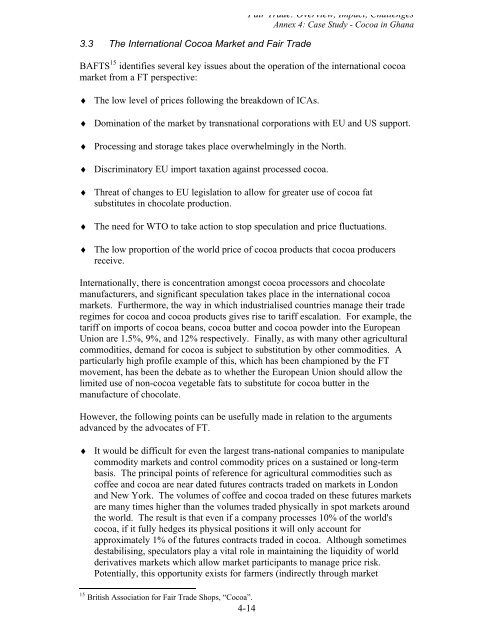Fair Trade: Overview, Impact, Challenges - Are you looking for one ...
Fair Trade: Overview, Impact, Challenges - Are you looking for one ...
Fair Trade: Overview, Impact, Challenges - Are you looking for one ...
Create successful ePaper yourself
Turn your PDF publications into a flip-book with our unique Google optimized e-Paper software.
3.3 The International Cocoa Market and <strong>Fair</strong> <strong>Trade</strong><br />
15<br />
British Association <strong>for</strong> <strong>Fair</strong> <strong>Trade</strong> Shops, “Cocoa”.<br />
4-14<br />
<strong>Fair</strong> <strong>Trade</strong>: <strong>Overview</strong>, <strong>Impact</strong>, <strong>Challenges</strong><br />
Annex 4: Case Study - Cocoa in Ghana<br />
BAFTS 15 identifies several key issues about the operation of the international cocoa<br />
market from a FT perspective:<br />
♦ The low level of prices following the breakdown of ICAs.<br />
♦ Domination of the market by transnational corporations with EU and US support.<br />
♦ Processing and storage takes place overwhelmingly in the North.<br />
♦ Discriminatory EU import taxation against processed cocoa.<br />
♦ Threat of changes to EU legislation to allow <strong>for</strong> greater use of cocoa fat<br />
substitutes in chocolate production.<br />
♦ The need <strong>for</strong> WTO to take action to stop speculation and price fluctuations.<br />
♦ The low proportion of the world price of cocoa products that cocoa producers<br />
receive.<br />
Internationally, there is concentration amongst cocoa processors and chocolate<br />
manufacturers, and significant speculation takes place in the international cocoa<br />
markets. Furthermore, the way in which industrialised countries manage their trade<br />
regimes <strong>for</strong> cocoa and cocoa products gives rise to tariff escalation. For example, the<br />
tariff on imports of cocoa beans, cocoa butter and cocoa powder into the European<br />
Union are 1.5%, 9%, and 12% respectively. Finally, as with many other agricultural<br />
commodities, demand <strong>for</strong> cocoa is subject to substitution by other commodities. A<br />
particularly high profile example of this, which has been champi<strong>one</strong>d by the FT<br />
movement, has been the debate as to whether the European Union should allow the<br />
limited use of non-cocoa vegetable fats to substitute <strong>for</strong> cocoa butter in the<br />
manufacture of chocolate.<br />
However, the following points can be usefully made in relation to the arguments<br />
advanced by the advocates of FT.<br />
♦ It would be difficult <strong>for</strong> even the largest trans-national companies to manipulate<br />
commodity markets and control commodity prices on a sustained or long-term<br />
basis. The principal points of reference <strong>for</strong> agricultural commodities such as<br />
coffee and cocoa are near dated futures contracts traded on markets in London<br />
and New York. The volumes of coffee and cocoa traded on these futures markets<br />
are many times higher than the volumes traded physically in spot markets around<br />
the world. The result is that even if a company processes 10% of the world's<br />
cocoa, if it fully hedges its physical positions it will only account <strong>for</strong><br />
approximately 1% of the futures contracts traded in cocoa. Although sometimes<br />
destabilising, speculators play a vital role in maintaining the liquidity of world<br />
derivatives markets which allow market participants to manage price risk.<br />
Potentially, this opportunity exists <strong>for</strong> farmers (indirectly through market
















![CynefinFramework final [Read-Only]](https://img.yumpu.com/19017304/1/190x135/cynefinframework-final-read-only.jpg?quality=85)